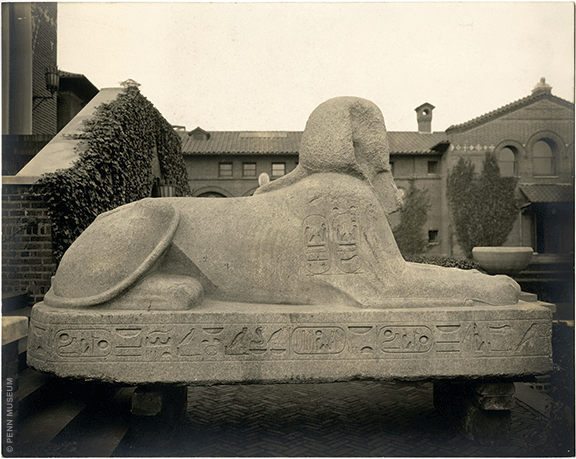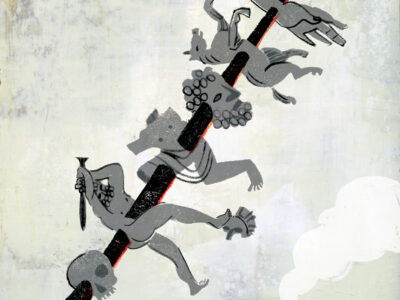
The Sphinx was coming.
Philadelphians guessed and wondered. They read news stories, including one in the Philadelphia Inquirer:“Fifty Men Will Move Big Sphinx.”
They couldn’t travel to Egypt themselves—transatlantic flight was only a dream, and only the very wealthy could afford a cruise down the Nile—but here was a giant 3,000-year-old artifact arriving in their own city, shipped from Egypt to its new home at the University Museum.
The Sphinx arrived that fall, 1913, on a German freighter. Its red granite weighed over 12 tons. A giant crane lifted it into a rail car that carried it from Port Richmond to the Philadelphia & Reading Railroad’s freight yard at 23rd and Arch streets. From there, a team of nine horses dragged it to the Museum on a wagon, where those 50 workmen rolled it to its ordained place in the courtyard.
East Coast weather soon threatened its open-air life, so today the Sphinx presides over the Egyptian Lower Gallery. It’s become “sort of an unofficial mascot” for the Museum, says associate curator Jennifer Houser Wegner C’91. Kids camp out next to it at “40 Winks with the Sphinx” sleepovers. The gift shop sells Sphinx mouse pads, mugs, and flasks. And now, from Wegner and her husband, Josef Wegner C’89 Gr’96, there is a book: The Sphinx That Traveled to Philadelphia (October 2015, University of Pennsylvania Press).
Both associate curators in the museum’s Egyptian section, the Wegners originally planned a children’s book. But once the research got rolling, they decided on a fuller history to mark the Sphinx’s century in Philadelphia. There were just too many gems in the archives to pass up, they say, plus the Sphinx is vital to the Museum’s history: it helped establish its global reputation and launched “a major golden age of Penn excavations in Egypt,” as Josef puts it.
Even today, it’s still the largest Egyptian Sphinx in the Americas.
The Wegners’ richly illustrated 256-page book goes deep into the Sphinx’s long life: what it meant in ancient Memphis, Egypt; who made it, and why; and the long story of how it came to Penn.
While Ancient Greek myths cast the sphinx as a people-eating monster, the Egyptians saw sphinxes as their protectors. They put them outside tombs and temples—carved statues with a lion’s body and a man’s head, usually modeled on their pharaoh. The Penn Museum’s Sphinx has inscriptions from Pharaoh Ramses II, who ruled Memphis around 1200 BCE.
Between its human head and the Ramses connection, many think of the Sphinx in living terms, and have since its arrival. The Wegners’ book reprints a newspaper’s jokey interview with it from 1913: “What are all these fragile buildings—not a pyramid I see. Where’s the palace, where’s the temple, where’s a home for such as me?”
In another 1913 article, also included in the book, the Sphinx is “unable to suppress his tears” after Cornell beats the Quakers in a football game.
But how did an Egyptian Sphinx wind up at the Penn Museum anyway?
Josef says that back in the 1900s, the museum mostly sponsored British excavations in Egypt rather than leading its own. It had formed a close relationship with the archaeologist Sir William Flinders Petrie, and when his latest dig—funded in part by the Museum—resulted in the Sphinx, Petrie offered it to the 26-year-old institution.
Its arrival sparked the Museum to begin leading its own excavations in Egypt, including at Memphis. Soon its team found parts of a palace near the Sphinx site. It had housed Pharaoh Merenptah, Ramses II’s son, and its columns now surround the Sphinx at the Penn Museum.
Jennifer says there are about 50,000 Egyptian objects in the Museum collection today, and most of them came during a “massive upsurge” in the 20 years right after the Sphinx arrived.
“Ours became one of the leading research collections in the United States,” Josef adds.
But back in 1913, most Philadelphians didn’t have research foremost on their minds. The Sphinx was the second-largest Egyptian monument to arrive in the US since the Central Park obelisk, and they just wanted to see it.
The Wegners write that thousands of people visited the Sphinx within days of its arrival, not only from Philadelphia but all over the East Coast.
Visitors ran their hands over the statue, feeling the ribs chiseled into its sides. They imagined life in Egypt, and what the Sphinx’s face looked like before weather and time wiped it clean. They wondered what Ramses would think of 1910s Philadelphia.
“People just had a lot of fun with it,” Josef says. “And they still do today.”
—Molly Petrilla C’06




